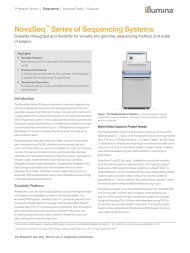Abstracts
ngsfinalprogram
ngsfinalprogram
Create successful ePaper yourself
Turn your PDF publications into a flip-book with our unique Google optimized e-Paper software.
Oral Presentation <strong>Abstracts</strong><br />
conformation capture techniques such as Hi-C<br />
are used to measure long-range interactions of<br />
DNA molecules in physical space. These tools<br />
employ crosslinking of chromatin in intact<br />
cells followed by intra-molecular ligation,<br />
joining DNA fragments that were physically<br />
nearby at the time of crosslink. Subsequent<br />
deep sequencing of these DNA junctions generates<br />
a genome-wide contact probability map<br />
that allows the 3D modeling of genomic conformation<br />
within a cell. The strong enrichment<br />
in Hi-C signal between genetically neighboring<br />
loci allows the scaffolding of entire chromosomes<br />
from fragmented draft assemblies.<br />
Hi-C signal also preserves the cellular origin<br />
of each DNA fragment and its interacting partner,<br />
allowing for deconvolution and assembly<br />
of multi-chromosome genomes from a mixed<br />
population of organisms. We have used Hi-C<br />
to scaffold whole genomes of animals, plants,<br />
fungi, as well as prokaryotes and archaea. We<br />
have also been able to use this data to annotate<br />
functional features of microbial genomes, such<br />
as centromeres in many fungal species. Additionally,<br />
we have applied our technology to<br />
diverse metagenomic populations such as craft<br />
beer, bacterial vaginosis infections, soil, and<br />
tree endophyte samples to discover and assemble<br />
the genomes of novel strains of known<br />
species as well as novel prokaryotes and<br />
eukaryotes. The high quality of Hi-C-based<br />
assemblies allows the simultaneous closing of<br />
numerous unculturable genomes, placement of<br />
plasmids within host genomes, and microbial<br />
strain deconvolution in a way not possible<br />
with other methods. Reference: Burton JN*,<br />
Liachko I*, Dunham MJ, Shendure J. Specieslevel<br />
deconvolution of metagenome assemblies<br />
with Hi-C-based contact probability maps. G3.<br />
2014, May 22;4(7):1339-46.<br />
n S6:3<br />
NEXT GENERATION SEQUENCING OF<br />
BRUCELLA MELITENSIS ISOLATES FROM<br />
KUWAIT AND COMPARATIVE GENOME<br />
ANALYSES<br />
A. S. Mustafa, F. Shaheed, N. Habibi, M. W.<br />
Khan;<br />
Kuwait University, Jabriya, KUWAIT.<br />
Human brucellosis is a zoonotic disease of<br />
worldwide occurrence. In Kuwait, almost all<br />
cases are caused by Brucella melitensis. Three<br />
different strains (biovars) of B. melitensis have<br />
been identified using classical techniques but<br />
the presence of very limited variation across<br />
strains makes it difficult to identify a particular<br />
strain using the classical molecular methods,<br />
e.g. PCR and Sanger sequencing. The aim of<br />
this study was to exploit the potential of next<br />
generation sequencing to identify the strain(s)<br />
of B. melitensis present in Kuwait, and also<br />
to find the extent of differences among the<br />
isolates of the same strain by comparative<br />
genome analyses. B. melitensis were isolated<br />
from 15 patients suspected of human brucellosis.<br />
The bacterial colonies from culture<br />
plates were suspended in saline and heated at<br />
95°C for 10 minutes. DNA released from the<br />
bacterial cells were purified using the QIAamp<br />
DNA Mini Kit (Qiagen). The isolated DNA<br />
were quantitated and checked for purity using<br />
a spectrophotometer (Epoch) and a fluorometer<br />
(Qubit), respectively. DNA libraries were<br />
prepared using the Nextera XT DNA Sample<br />
Preparation Kit (Illumina) and sequenced using<br />
the next generation sequence platform of<br />
MiSeq (Illumina) using standard procedures.<br />
The obtained sequence files were aligned to<br />
the sequences of three known biovars of B.<br />
melitensis available in the NCBI data base,<br />
i.e. biovar 1 str. 16M, biovar 2 str. 63/9, and<br />
biovar 3 str. Ether. The alignment and variant<br />
calling were performed using ‘bwa mem’<br />
and SAMtools/VCFtools, respectively. The<br />
results showed that the genome size of all the<br />
isolates was around 3.3 mega base pairs, and<br />
24<br />
ASM Conferences



